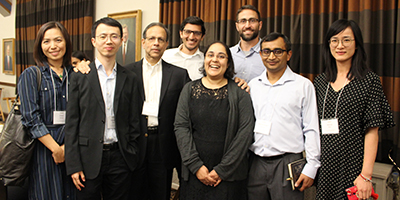Final stop — Purdue University
There had not been any senior IS faculty for some time at Krannert before I joined, and the area had suffered as a result. Both Rick Cosier, the school’s relatively new dean, and his senior associate dean, Bob Plante, were eager to change this situation. We were allowed to recruit two new junior faculty in my first year, and we recruited Jungpil Hahn, currently department chair at National University of Singapore, and Karthik Kannan, currently a chaired professor at Krannert. Among the others we recruited in the next several years were Jeffrey Hu, at present a chaired professor at Georgia Tech, and Mohammad Rahman, a former PhD student of ours and now an associate professor at Krannert, who was recognized as one of 2017’s “40 Best Business Professors under 40” and was a 2018 winner of INFORMS Information System Society’s Sandy Slaughter Early Career Award. I consider myself fortunate that at every university where I worked, I could be instrumental in recruiting some talented junior faculty, who have become successful scholars in due course. Jungpil and Jeffrey are long gone from Purdue, but we have remained good friends.

Two of the most noteworthy developments concerning IS that took place during my tenure at Krannert were both in collaboration with the quantitative methods area. One of them was the development of an MS program in business analytics and information management (BAIM), with equal emphasis on techniques and technologies along the lines of the recommendation made by McKinsey & Co for success in the age of big data. Soon after its start in 2016, this program became Krannert’s strongest master’s program based on various criteria, including incoming student background and placement of graduates. I taught a required course in this program and thoroughly enjoyed it. From their feedback, it appeared that the students also liked the course and felt it helped them in both their job interviews and jobs. I suppose I offered a useful course, finally.
The other important development, also in collaboration with quantitative methods, was the establishment of a center in early 2016 with seed money support for two years from the dean. Initially called the Business Information and Analytics Center (BIAC), the objective of this center was to enhance research and dissemination of state-of-the-art information technologies and analytical techniques to convert the vast amounts of corporate data available today into practical business decisions. In the first couple of years, the center organized several case competitions and data dives (the latter spearheaded by Mohammad) as well as a research conference, which were all well received. It also succeeded in generating some funds from external and internal sources, but was still in need of a major gift to be sustainable in the long run. That changed in 2019, when Purdue alumnus John Krenicki, and his wife, Donna, made such a gift to the center and BIAC was renamed the Krenicki Center for Business Analytics and Machine Learning. As chair of its four-member board of directors, I was heavily involved with the center from its inception until mid-2018, when I decided to step away from this role and Karthik took over the helm of the center. Soon after that, I received brief but very nice notes from two top administrators of the university, which indicated, among other things, that the center had already gained some traction at the university level.
In the fall of 2019, at the initiative of Mohammad and with the management department’s sponsorship, a conference was organized at Krannert for my upcoming retirement. I was initially quite uncomfortable about it myself and asked Mohammad not to go through it, but like most of my other colleagues, he does not listen to me often and did not this time either. The conference, however, turned out to be a truly enjoyable event, at least for me. I was delighted to see many of our former doctoral students and colleagues who attended in addition to a number of well-known IS scholars, including the presidents of INFORMS and AIS, the latter being the primary academic organization in IS. The attendees came from all over USA and Canada as well as from China, Hong Kong, and Singapore. I do not really know why they took the trouble to come, but was very happy that they did. This event was a wonderful farewell gift for me.
Epilogue
Now that I am at the end of my professional career, I am amazed how fast these 45 years have passed since I entered the PhD program in 1975 — it feels like just the other day. I am grateful to my teachers as well as numerous students, colleagues, and friends who helped make this long journey rewarding for me in many ways. I am particularly indebted to those who collaborated with me on research and other projects or worked as my teaching assistants or administrative support because they had to put up with my many shortcomings and idiosyncrasies up-close. Thanks to all of them, I had a fulfilling run for nearly half a century.





